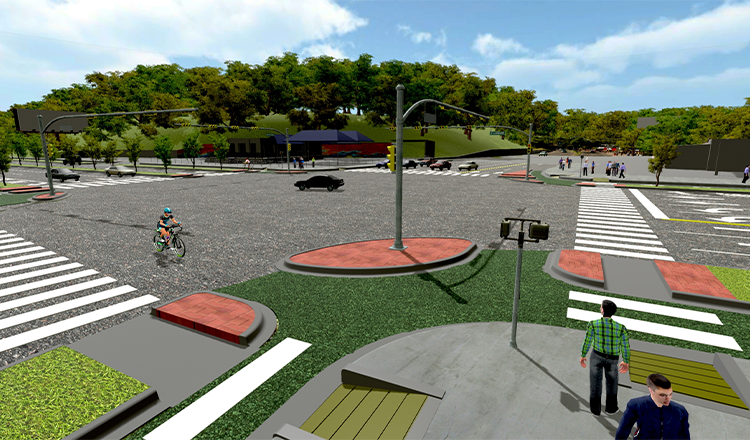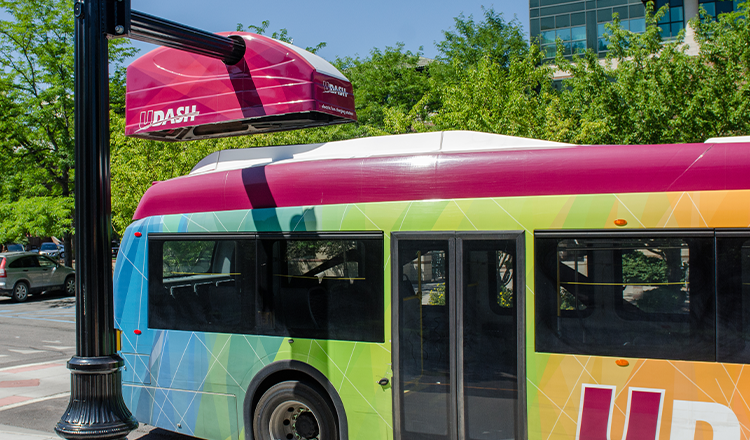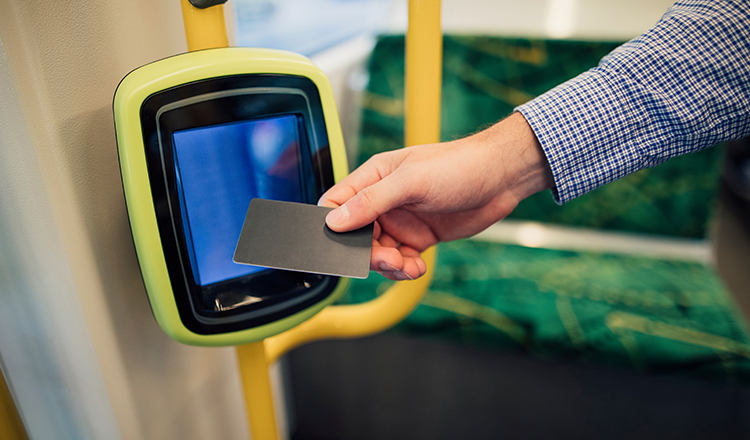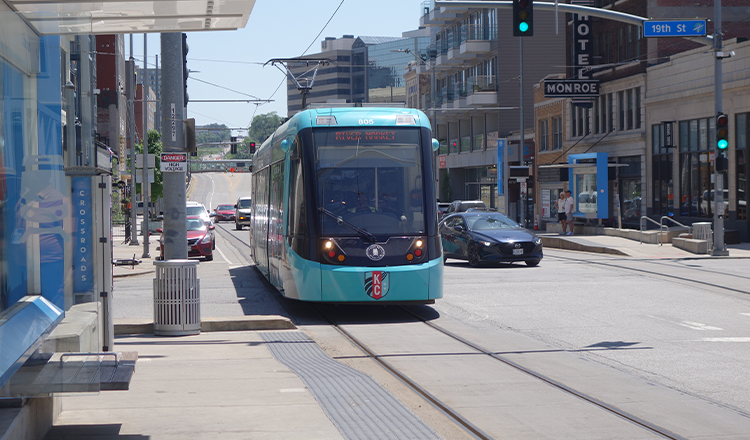
Leverage the IIJA to Prepare Your Transit Agency for the Next Generation of Mobility
By Shyam Kannan and Nathan Macek
Across the United States, transit agencies are facing a generational dilemma. Federal relief funding helped keep their operations afloat while ridership evaporated during the COVID 19-induced era of stay-at-home orders and continues through the current stickiness of white-collar work-from-home patterns. But as the country has started to move around again, agencies are realizing that what was once happening slowly — technology disrupting transportation, changing mobility patterns, customers accustomed to the “instant economy” — is now happening all at once. This means that simply restoring the transit paradigm of 2019 isn’t a recipe for successful recovery. Continued uncertainty about the permanence of mobile work, continued innovation from tech-enabled new mobility, and changing travel behaviors mean that legacy service, operations and business models need an upgrade.
Against this backdrop is the once-in-a-generation infusion of investment dollars from the 2021 Infrastructure Investment and Jobs Act, also referred to as the Bipartisan Infrastructure Law. This infusion of federal funding provides the largest investment in passenger rail and public transportation capital programs in the nation’s history, including new funding of $66 billion for passenger rail, $31.5 billion for public transportation, and an approximately 32% increase in formula program contract authority for transit programs as compared to the final years of the FAST Act.
Instead of deploying these resources to rebuild yesterday’s business model, transit agencies can act now to respond to dynamic changes from customers and competition so that this historic investment in transit builds the systems we need, not just the systems we had. Cities, counties, planning organizations and transit agencies across the country have the opportunity to rethink and align their capital investment approach to address the need for a strategic reset and come back stronger than ever.
Here are four strategies to help agencies take advantage of this moment in history and act thoughtfully, decisively and sustainably to prepare for the next generation of mobility.

1. Embrace Mobility Equity to Grow Transit Ridership
The pandemic brought to light the outsize role that public transit has on our most vulnerable populations, many of whom were and are essential workers and rely on transit to conduct their daily lives. Persons of color and low-income populations have historically taken more transit trips than other demographics, but transit agencies have not always prioritized their needs and geographies in capital investment plans. Given increased emphasis on equity in the IIJA, requiring the Federal Transit Administration and U.S. Department of Transportation to integrate equity considerations into funding decisions, agencies can re-examine their networks, capital plans and engagement to embrace equity as a growth opportunity to increase ridership.
Orange County, Florida, for example, is updating its Title VI plan to proactively improve its project planning process so it can be used as a guide for equity-oriented planning that can ameliorate historically adverse effects on disadvantaged communities. On the west coast, the Oregon Department of Transportation commissioned an outcome-oriented Social Equity White Paper, which examines what types of support may be needed by different people in order to achieve the same level of success. This body of work will inform critical elements of the Oregon Statewide Transportation Plan. In both cases, the “equity first” approach means that these agencies may be better positioned for funding that explicitly requires this thinking.
Some agencies are digging deeper than demographics to drive decision-making. Our work with the City of Austin identified areas with a higher than average prevalence of health issues such as coronary heart disease, high blood pressure, diabetes, poor mental health, poor physical health, stroke, obesity and lack of leisure time and/or physical activity, along with lack of access to health care. Using this information, the city targeted investments in transit, pedestrian and cycling facilities to enable residents to have greater access to transportation that encourages more physical activity in those areas.
Advancing Transit in Underserved Communities
Many transit agencies were not built to serve places where today’s vulnerable and essential customers live or need to go. These populations represent huge swaths of the mobility market and may be critically underserved, and the current administration has made it a priority to use the historic funding influx to fix these “transit deserts.” Using IIJA funding to put these customers and geographies front and center in future planning could be a pathway to growing ridership and addressing inequities. Providing more opportunities for vulnerable populations to access employment, education and critical services throughout the course of the day and ensuring high-capacity, high-frequency transit for those who need it most can be a core strategy for restoring ridership on public transit. Some agencies are already acting with this intention, recognizing that better serving this customer cohort is a strategic priority.

2. Put Your Agency on a Low-Carb(on) Diet
Policy and politics are dictating a quickened pace for zero emissions mobility, and initiatives to reduce and fund replacements to carbon-based fuel sources are specifically prioritized and funded in the IIJA. Agencies that haven’t started planning should begin now, and agencies that are on their way to zero emissions should take advantage of federal funding to bring them further along the path.
If your agency hasn’t already started, now is the right time to develop or update a transition plan for zero emissions. Battery and electric technology along with improvements to range and reliability are finally putting electrified mobility within reach. Meanwhile, the arrival of commercially viable hydrogen fuel cell technologies might fall within the timeframe of a typical agency fleet and facilities plan.
Fleet owners, local government leaders and transportation officials are expected to lead the charge and must manage this transition in an efficient, strategic way while navigating a myriad of actions and dependencies. This includes considerations such as utility company coordination and sourcing/delivery of power, maintenance facilities, vehicle specifications, operations and route design, workforce training and financial planning.
A New Tool to Plan for Zero Emissions
A critical component when piloting or expanding a zero emissions transition is understanding and preparing for the power consumption demands and vehicle capabilities in the network. A detailed analysis early on will put an agency in the best position to avoid delays during implementation and disruption in your operations. Our Zero+ Fleet Optimization and Feasibility Modeling Tool helps owners of public and private medium- and heavy-duty truck, bus and car fleets evaluate a transition to electric, hydrogen fuel cell, hybrid or compressed natural gas. The tool’s tailored reports and recommendations lead to better-informed decisions about fuel type, fleet size, routes, infrastructure, facilities, maintenance and more. Kitsap Transit and the San Mateo County Transit District are among the entities that have taken advantage of this tool to plan their zero emissions future.

3. Information Technology Is Transit Infrastructure
The transportation industry is changing rapidly due in part to the tech sector, which is innovating faster than many transit agencies can adapt and heavily influencing how people choose to move about. From ride-hailing services to app-based payments to scooters and bikeshares, technology has disrupted the transportation industry and the transit sector specifically for at least the past decade, and the pandemic only accelerated the massive shifts already underway in mobility behavior. Transit agencies that were already playing catch-up before the pandemic now find themselves in danger of being outflanked not just by supply and demand, but by technology. This is precisely the time when transit agencies have a strategic imperative to make thoughtful decisions, turn competition from the private sector into collaboration, and seek grant funding to integrate new technologies to create mobility ecosystems that better serve their existing and new customer’s needs.
Some savvy communities were already preparing for the future of transportation technology before the pandemic and are better prepared for today’s competitive landscape. The Regional Transportation Commission of Washoe, Nevada, is planning for new technologies through its recent Advanced Mobility Plan, incorporating everything from autonomous vehicles to mobility options. The City of Lincoln, Nebraska has create a framework to facilitate a technology-enhanced multimodal vision for the city, including the deployment of a small fleet of autonomous microshuttles that serve the downtown district. And Pennsylvania is moving toward all-digital delivery in its transportation projects.
Funding Sources for Technology Advancement
For those that haven’t yet embraced new technology, the IIJA gives them the opportunity to do so. The law significantly increases mass transit formula funding, which opens the possibility for transit properties to examine opportunities to upgrade or integrate new technologies to optimize their operations. It also increases overall funding for the Public Transportation Innovation program, which awards funding to advance research and development. The roughly $37 million in 2022 (increasing to $40 million by 2026) will support innovation and development activities that seek to improve public transportation systems to provide more efficient and effective delivery of public transportation services, including technology and technological capacity improvements. It has an expansive reach, including demonstration, deployment or evaluation projects, and even funds research activities that relate to the development and deployment of new and innovative ideas, practices and approaches.
Many transit agencies have acknowledged the need to figure out a path forward for things like app-based fare and payment systems, real-time vehicle position data feeds, “digital twins” of hard infrastructure to improve asset management and maintenance regimes, pilots that integrate new mobility providers into the transit ecosystem and more. As these agencies contemplate leveraging the new infrastructure money for items like fleet, facilities, guideway and expansion, it makes sense for them to also pursue funding for the information technology infrastructure that will set them up to stay competitive in the future.

4. Make the Connection Between Transit and Placemaking
Home-based work trips and therefore agency ridership and farebox revenues are likely to be in flux for some time as the workforce adjusts to new flexibility and commuting patterns. Meanwhile, the fastest-growing trip market in the U.S. overall is non-work trips, a dominant segment of the market that isn’t always effectively served by peak-oriented transit. Transit-oriented communities tend to generate a wide variety of trips at all times of the week and all times of day. Creating and capturing these types of trips should be part of the strategic future for mobility.
One of the best ways if not the best way to generate all-day ridership is through transit-oriented development, which expands the customer base and meets a broad range of local and regional objectives: improving mobility, offering lower costs of living, providing mobility equity, attracting investment, serving new markets and reducing congestion. But until now, funding and financing this type of development through traditional sources have been complex.
The IIJA brings significant new resources to the TOD table:
- The January 2022 Notice of Funding Opportunity for RAISE grants makes $1.5 billion available for local and regional project assistance — up to $25 million per project. The policy provisions include language to encourage metropolitan planning to better connect housing to transit. In many places this means the resulting development will be a more “walkable” community.
- The policies also include specific references to TOD planning, which is now expanded to include “site specific plans” in addition to comprehensive plans, with approximately $75 million allocated to planning.
- The IIJA enhances a key program that funds much of the country’s bicycle and pedestrian facilities — the Transportation Alternatives Program. The bill authorizes nearly 70 percent more money for the TAP, from $850 million to an average of $1.44 billion per year.
- Furthermore, the law expands use of Safe Routes to School funding to encourage students to ride bicycles to school, opening the doors for potential coordination with schools seeking infrastructure funding.
- It also creates a new Active Transportation Infrastructure Investment Program that supports projects that build out, fill gaps or connect to active transportation networks.
- For the right projects, these tools allow a project sponsor to create a streamlined funding strategy. And to date there is not a huge list of projects using these resources. USDOT officials are eager to see a robust pipeline of projects that use the funding and financing programs they have put in place.
Adapt Your Thinking and Leverage New Resources to Lead in the Future
Transit may have changed more in the last 100 months than it has in the last 100 years, and the pace is quickening. Agency professionals have a choice: Use the unprecedented funding infusion from the IIJA to confront change head-on or roll the dice and hope that yesterday’s business models will work for tomorrow’s mobility.
Transit agencies and organizations need to adapt, reinvent themselves and even outflank the disruptors to achieve their mission and best serve their communities. Savvy transportation leaders now have access to one key part — the funding to explore and implement innovations that create a more resilient organization and operation. This is the moment in time to re-imagine their agencies’ purpose, re-examine their customers’ needs, and re-invest in their systems to deliver more value. Wise use of the infusion of federal funds will allow forward-looking agencies to close the gap on innovation and implementation to build the mobility system for the next generation.



